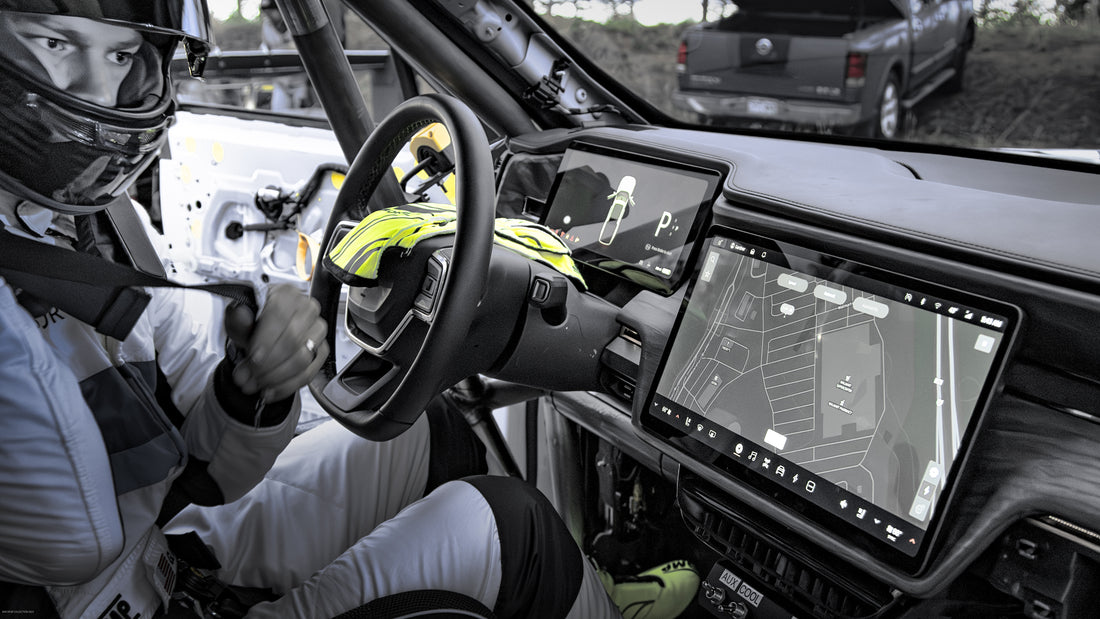
Rivian Race to the Clouds
All photos curtesy of Rob Watt @BarSpurCollection
The Broadmoor Pikes Peak International Hill Climb, brought to you by Gran Turismo Climb is undoubtedly one of the most renowned Hill Climbs in the world. Spanning over 12 miles of road, featuring a whopping 156 turns, and boasting an elevation gain of 4,700 ft, Pikes Peak offers motorsport drivers an exhilarating rush of adrenaline. What sets it apart is the unpredictable weather conditions, with the potential for the blazing sun at the start of the race and snowfall at the finish line.
In 1981, Joe Ball made history by driving the first electric car up Pikes Peak. He accomplished this feat in a Sears electric car, albeit taking more than 32 minutes to reach the summit. This year marks the 101st edition of the Hill Climb, and we had the privilege of interviewing Gardner Nichols, who will be piloting a Rivian R1T in this prestigious event.

Mobility EVo: Hi Gardner, to kick things off, can you give a little background on yourself?
Gardner: My name is Gardner Nichols. I grew up in Colorado, born and raised, and I've always been passionate about cars, motorsports, and racing. I actually got the opportunity to get into go-karting when I was about 12 years old, just locally. And then I saved up money, got my own car, got into autocross, and then eventually got into time attack competitions and club racing when I was in college.
When I was about 16 years old, I was sort of apprenticing for Paul Dallenbach, who's a longtime Pikes Peak competitor. He lives near where I grew up and I was lucky enough to meet him and he took me under his wing for three summers in a row where I was able to work with his team and help out with a bunch of stuff. I was mostly the tire guy for his Pikes Peak efforts. It was great to learn about car setup and learn from someone with so much experience.
I went to school at CU Boulder for mechanical engineering. In college, I was also lucky enough to intern for BMW Motorsport North America where I helped with the Z4 GTLM cars. I think my engineering degree combined with some driving and motorsport experience helped me to land a job right out of college at Fiat Chrysler doing vehicle dynamics and test driving.
I spent almost four years at Fiat Chrysler, meanwhile competing in time attack and getting into some club racing. I left that position and took a year to do my own gig, tried doing contract test driving and automotive engineering stuff and eventually, I landed a job at Rivian. I actually met my current boss at Rivian while I was working with Dallenbach and his Pikes Peak team as a teenager.
I've been at Rivian for about 2.5 years working as an engineer and test driver. Competing at Pikes Peak sort of represents a full-circle moment for me. This has always been a dream of mine!
Mobility EVo: Very cool. Very cool. What are your goals for the race? The Volkswagen ID.R has the record, at 7:57. That’s obviously fast, but what are your goals for the race?
Gardner: Pikes Peak has recognized the production truck as a vehicle to set a record. So there is the ‘Production Truck Record’, which I'd like to achieve. There is another truck competing this year, so I suppose we'll be vying for that. And then there is a ‘Production Electric Vehicle Record’. I think it's 11:02. It's not a slow time by any means, I think it’s a Tesla Model 3 driven by Blake Fuller, so that is sort of hanging out there as a stretch goal. The truck is still a production truck and it weighs around 7,000 pounds. It's very production spec, which I'm a huge fan of.
This truck still has a working motorized tonneau cover; those alone weigh about 45 kilograms. It still has all the amenities like an onboard air compressor and air conditioning. We removed a lot of the interior for the roll cage, but that was really purely to fit the safety equipment. Going for the production EV record is a stretch goal, but I think the overall goals for the event are just to make it to the top of the respectable times. We're hoping for good weather.
Mobility EVo: That's the one thing with Pikes Peak, is the unknowns related to weather. It might be one weather condition at the bottom, and then you get to the top and it's snowing. That’s always the variable that’s hard to deal with.
Gardner: Yeah. We just came off of a test weekend on the mountain and on both days it was rainy, wet, and foggy. Visibility was pretty bad. It actually made for a really good practice weekend because it could be like that on race day. It was sort of like, here are some of the worst conditions that you can expect. It's good to drive the truck in those conditions and get a feel for the course.

Mobility EVo: That makes sense. The weather can be crazy here in Colorado, especially at Pikes Peak. So the only thing that you've really done was kind of strip out the interior to fit the cage in there and that's it. Any other modifications to the truck?
Gardner: The rule book has production vehicle rules and what modifications are allowed. For an ICE vehicle, you’re allowed to flash ECUs and you're allowed 22-inch to modify the exhaust. For a lot of turbocharged cars, a modified exhaust and an ECU change can make some huge changes such as adding anti-lag to a production car pretty easily. So, we had to look through those. We removed the interior for the safety equipment. We have the big cage, the racing seat and we removed all the other seats because the rules say that you need to do that. We have high-performance DOT Pirelli tires. If you buy a Rivian right now, it comes on Pirelli tires, we’re just running the tire from a Lamborghini SUV. They’re a little bit stickier.
Mobility EVo: Which tire from Pirelli?
Gardner: It’s the P Zero Corsa 22-inch and then we also have a Pirelli Trofeo R, again still a DOT tire. You have to use the factory wheels, so we have to run a square setup. Ideally, you'd run a staggered setup with a wider tire on the rear to maximize performance, but per the rules, stock wheels, so we have different tires and then we're allowed to run different brake pads. We have a few pretty aggressive pads from Hawk Performance, between a DTC60, DTC70, or DTC80.
There is an interesting thing in the rules where the production car record says you need to keep the brake hardware the same, but for the production electric vehicle record, you're allowed to change out brake rotors and brake calipers, which is pretty wild. We looked into doing that, but we decided not to. We wanted this to be overall production spec, not just electric specific. We’re also able to go into the ECU and change a few parameters to maximize the torque vectoring performance. We considered also removing the 110mph speed limiter, which we could do per the rules but decided against it so it’s as close to a customer car as possible.
Mobility EVo: Touching on the brakes there a little bit, I think Rivian’s have three different modes for regen. Is there a certain mode you will run on, or have you tweaked that at all?
Gardner: They may have had three, but I think now they just have two- standard and high. We played around with that this past weekend, and I think the less regen we have, the better. For this event, if we can just really lean on the foundation brake system and minimize the amount of extra heat going into the motors and the batteries, that will help our strategy there.
Mobility EVo: That makes sense. My business partner and I were talking about that the other day thinking, okay, well in an ICE car you're downshifting, and you let the motor brake all used in a combination with the standard brakes. Now how does it work in an EV with the regen system? So you're just saying, no, you’re just going to rely on the brakes?
Gardner: As much as we can. In most ICE vehicles, you're relying very little on the engine deceleration in a motorsport situation. You have a bit of that for sure. The driving style in the Rivian is interesting. On the street, you can get up to a quarter of a G of deceleration just from the regen torque. You need to change your driving style in a motorsport situation. It's almost like driving a car with a really high downforce, where if you let off the gas you have all this drag to help slow you down. It's sort of this underlying offset on your deceleration. As you’re coming into corners, you start dialing in steering, you have this quarter G of deceleration that's always there until you start getting back on the accelerator pedal. It takes a little bit of driving style change to try to maximize that as well.

Mobility EVo: Is the R1T your daily driver too?
Gardner: It is, yeah.
Mobility EVo: You have to get rid of that mindset of a daily driver and that it’s now a race truck. That’s got to take some getting used to. What do you think are some of the advantages and disadvantages of driving an EV, or specifically a Rivian, in the Hill Climb versus an internal combustion engine?
Gardner: With everything, there are pluses and minuses. Our biggest advantage is probably our launch and then coming out of really tight hairpins, with the immediate torque, we can punch out of those hairpins really fast, much faster than most cars up there. Our top speed is only 110 mph, which is a limitation. Weight is the other thing, it's just a lot of weight management up there. You generate a lot of heat accelerating and braking with that much weight. Then, of course, you don't necessarily lose as much horsepower going up the hill at higher elevations.
There are trade-offs with cooling because your motors and your batteries will get hot. That's probably the biggest thing that we'll be battling against. The ability to tune stuff, like the torque vectoring, even in my day job with Rivian, has been really cool. Maximizing performance or maximizing how the car feels to drive in a certain situation. Maybe that's a little bit of an advantage over an ICE vehicle, where we don't have to change hardware in our differentials or suspension necessarily or anything like that.
Mobility EVo: Going back to the weather, do you have any plans for coping with the various weather patterns you can get on the Hill Climb?
Gardner: For tires, we really only have the two tires from Pirelli. I've considered if it's really bad weather, maybe asking Pirelli to give us another set of more mild tires than the Corsa tires. We ran the Corsa tire this last weekend in the wet and it actually seemed to do pretty well. We were able to get heat into the tires pretty easily. But otherwise, I think it's really down to the driver. For the car setup, we're not going to do a whole lot of changes. We might change the alignment a little bit from the factory setup. I think it’s just a matter of driving, driving to the conditions, driving maturely, and being really observant of the conditions changing around you.
Corner to corner, you're constantly judging the amount of brake output you get with the car and the amount of lateral acceleration you can pull in the car and every corner you're evaluating to change your driving style as the car gets hot, performance degrades, the road gets colder, or if you have rain, you're constantly adjusting your driving style to account for that.
Mobility EVo: That makes sense. You talked about heat obviously being a downside. Are you going to pre-condition the battery to maximize efficiency?
Gardner: We’re talking about that right now. We’re trying to decide how much of that we want to do. As you said, it'll maximize efficiency right off the line, but the batteries are going to get hot regardless. If they start a little bit colder than normal, we'll probably have 'em up to temp within a mile I bet. That’s an ongoing conversation. We might test it a little bit during race week. We get a few practice days leading up to race day and it'll be a good time to test that out.
Mobility EVo: Where do you charge, and do you charge to 100% SOC?
Gardner: During the test weekend we had our shop based out of Euro Cars Collision in Colorado Springs. They were nice enough to lend us space as a home base, which is great. We just got a level two charger in there on Saturday. On Friday evening before the test weekend, we didn't really have a charging solution in the shop and we had to drive six minutes away to an EA charger, just south of Colorado Springs. It’s funny driving the Pikes Peak truck with a full roll cage and everything. It's still street-legal, but just pulling up next to everyone else and plugging in was funny.
The goal is to start probably at 95% or more SOC. We’re burning probably about 15% on the lower section of the mountain. While we're up there for the practice days, we might not have to charge between runs. But Optima Batteries, who's another sponsor, has gotten on board and is allowing us to use their mobile power station, which is really cool. I think it's in conjunction with DC Engineering. It’s essentially a level two charger on a trailer and we'll have access to that up there during the practice days. If we need to keep a little bit more heat in the battery or if we need to just top off a little bit between runs, we'll have access to that, which is really great to have that ability.
Mobility EVo: I think there were more last year, but I only counted three EVs this year. I might be wrong on that, but I think it’s Romain Dumas in the Ford Supervan, you in the Rivian R1T, and then Randy Pobst in the Tesla Model S Plaid, is that it?
Gardner: I think so. There is the BMW XM, but that's a hybrid of course. Oh, and Lucy Block is running the Sierra cars, the electric Sierra car.
Mobility EVo: Oh, it's electric?
Gardner: Yeah, they'll have the gas one and then she was up there this past weekend with the all-electric one, which is pretty cool.

Mobility EVo: Touching on that, who do you think your competitor is? You have Tanner Faust, Randy Pobst, Loni Unser, Rhys Millen, who I think is, it's his 27th year on the Hill climb this year, all in the Exhibition class and a few others. Who’s your biggest competitor and who do you look forward to competing against?
Gardner: We have Tanner Foust running the Radford Type 62-2, that thing is going to be really fast. Of course, Rhys Millen going for the production vehicle record in the BMW M8. I think my biggest competition is a Ford Shelby Super Snake Sport piloted by Robert Prilika.
It’s 770 horsepower or something like that, which is probably the closest vehicle to mine. It’s still a pickup truck. I don't know if it can be considered a production truck if it's a tuned vehicle. It's not really off the factory floor, but that's probably my closest competition. Otherwise, I think the biggest competition might just be the weather, myself, and the vehicle probably. We’ll have our thermal budget, and make sure that we use that the most effectively throughout the run with the batteries, motors, and brakes.
That's the cool thing with the Hill Climb. You get such a diverse group of cars overall. It’s a cool competition where the competitors can go up there and really just focus on what they’re doing and just try to maximize their run. That’s what we're focusing on.
Mobility EVo: Piggybacking off of that, are there any cars that you're most excited to see up there?
Gardner: Oh man. Both the Porsches that Donohue and Zwart are running are both gorgeous cars. I'm really excited to see the Supervan. They were up here this past weekend and they let us poke around and ask them some questions. That thing is wild. It is really fast. It was setting the fastest times in the testing sessions.
Mobility EVo: Romaine's got the overall record in the Hill Climb, right?
Gardner: He does, yeah. And that thing, you know, it's like a tube frame car. It looks like a prototype car that they just threw into Photoshop and stretched it vertically. The proportions are like that as well. Looks very much like a prototype car with the flying buttresses and all the aero. It's pretty wild. That thing's exciting. I'm excited to see Raphael Astier running the Alpine A110 GT4 Evo. That thing is just pretty. There are so many cool cars up there. I'm always excited to see the Emotion Engineering Porsche GT3R. That thing sounds wild.
Mobility EVo: I think the Hoonipigasus is supposed to be up there, right? Because last year when Ken Block was driving it, it broke down. I think his daughter is driving it up the Hill, right?
Gardner: She's going to do a tribute run. I actually worked with the BBI guys in 2020 helping with their Pikes Peak effort. We ran Sunny, which was a 911 GT2 RS Clubsport. I actually helped assemble the Hoonipigasus at their shop in Huntington the night before the media launch! I was there until 1:00 AM. It was a funny story, I popped over to say hi to the guys and see what they were up to and they're like, “Come back here, check this thing out. No one knows about this.” And sure enough, it was in a million pieces. They’re like, “The media launch is tomorrow”. I brought a change of clothing for some reason and I'm like, “All right, put me on something.” That was a fun time. They'll be up there and that will be really cool to see that thing driving around.
Mobility EVo: Definitely. Obviously, we wish Ken was piloting it. Such an unfortunate accident that happened earlier this year.
Gardner: Yeah, it's really unfortunate, really sad. He was so iconic and after doing the film up at Pikes Peak, he was familiar with the road and familiar with the community. It would've been really cool to see that thing pushed to the ragged edge.
Mobility EVo: It’s hard to think of someone more iconic in the automotive world. Someone that's done so much for the automotive community. Just a terrible tragedy.
Gardner: Yeah, it's cool to see his wife and daughter getting involved and staying involved with the community. It's exciting to see them both up at Pikes Peak this year for sure.

Mobility EVo: How do you think electric vehicles will impact the future of motorsports and racing events such as the Hill Climb?
Gardner: There are definitely pluses and minuses to it, like everything. I love seeing some of the stuff like this weekend at the 24 hours of Le Mans, all the hybrid cars that can use electric as a torque fill to maximize the overall vehicle performance. WRC now is using hybrid vehicles as well. I think there's definitely a future in it, to transition to electric and have a different powertrain setup. I would say for hill climb racing, it's ideal because you get these shorter stints, and you get instant torque.
For hill climb racing, it might become more dominant, who knows, especially as battery technology advances in the coming years and as we get higher power density and we can have smaller packs. It’s cool to see what the Supervan is doing. It's a smaller battery at 50 kWh for a motorsport setting. They're really showing the capability, which is pretty cool. I think Porsche with their Cayman GT4 e-performance, the all-electric race car version. I’m excited to see what they end up doing with that.
Mobility EVo: The noise that thing makes is wild. I remember watching some videos on that over the last year. That thing is crazy. Outside of racing, are there any EVs that you're excited about in the future or that are on the road right now?
Gardner: I'm interested in seeing what the Porsche Cayenne, Macan, or Cayman EVs are doing. I've seen some stuff that’s being developed right now. The ICE versions of those cars are great examples of what you can do. I have high expectations for those and I’m excited to see those. I would really love to drive a Corvette E-Ray, it's a hybrid with an EV front axle, that's really cool. I've always wanted to drive the Kia EV6 GT with drift mode and a mechanical limited-slip differential. I would love to drive one of those.
I'm lucky that I got to help develop and tune the drift mode on the Rivian a bit. It's pretty cool what you can do with four motors and then even the dual motor setup, but I think it's cool that Kia used a mechanical limited-slip diff. I would love to drive one of those on a closed surface.
Mobility EVo: One last question. Outside of Pikes Peak, are there any other races in the future like Goodwood that you’ll participate in?
Gardner: Boy, if I get invited to Goodwood, I would hop on that. No hesitation. We have this R1T with a roll cage in it and the team is sort of brainstorming what else we could do with it. All the upfront work of getting the roll cage in, which is a pretty big challenge, creatively and technically, to get this car prepared. What else could we do? I know there's the Colorado Hill Climb Association, so they do some hill climbs in the state, we've considered those. There are the NORRA off-road racing events.
I don't know, we have a few things on our radar. I don't know if any of your viewers have suggestions of where they'd love to see a R1T racing? We have some great sponsors who’ve helped this come to fruition. I think, if there's enough interest in us wanting to do more events, maybe we can get sponsors back on board.

Mobility EVo: Any last words and shoutouts to sponsors?
Gardner: I just want to thank you for having me on and thanks for the support. I appreciate it. We need all the luck we can get up there, whether it's for the truck or for the weather for sure. I looked at the live camera yesterday and it was still snowing up on top.
I'd love to thank Pirelli Tires and Optima Batteries for really making this effort happen. Without their support, I’m not sure we'd be seeing a Rivian at Pikes Peak. I really appreciate those guys. Monroe Intelligent Suspension, which is the supplier for the cool hydraulically cross-linked suspension on the R1T. They've been supporting us through this as well. Rossmönster Vans up in Longmont, Aspen Snowmass Sotheby's, and Hawk Performance for our brake supplier.
Mobility EVo: Awesome. I love this event. It's such a cool, historical, and iconic event. If I don't talk to you before the race, good luck, we'll be watching and cheering for you.
Gardner: Awesome. All right. Thank you, John.
All photos curtesy of Rob Watt @BarSpurCollection





